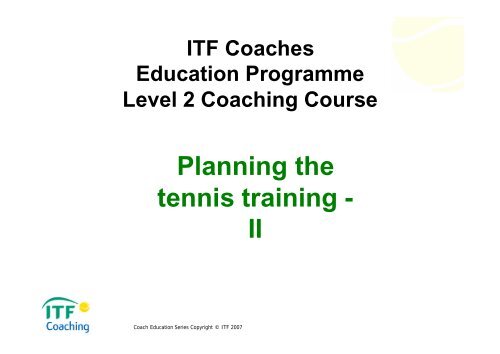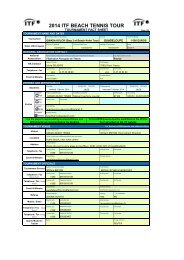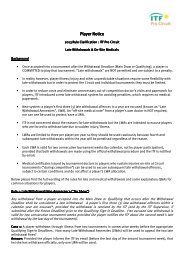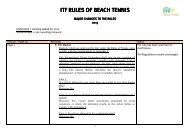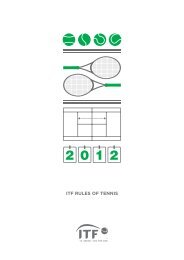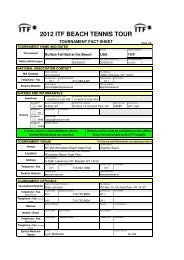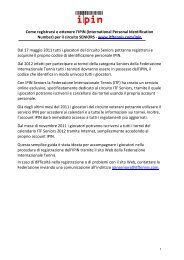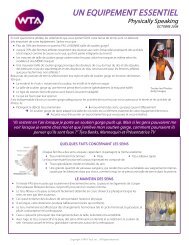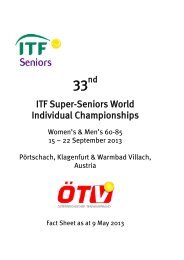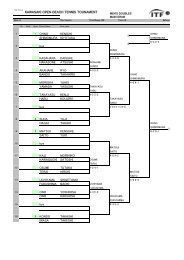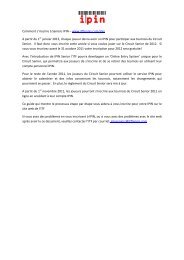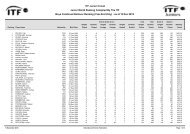29. ITF Level 2 Coaching Course - Planning the tennis training - II
29. ITF Level 2 Coaching Course - Planning the tennis training - II
29. ITF Level 2 Coaching Course - Planning the tennis training - II
You also want an ePaper? Increase the reach of your titles
YUMPU automatically turns print PDFs into web optimized ePapers that Google loves.
<strong>ITF</strong> Coaches<br />
Education Programme<br />
<strong>Level</strong> 2 <strong>Coaching</strong> <strong>Course</strong><br />
<strong>Planning</strong> <strong>the</strong><br />
<strong>tennis</strong> <strong>training</strong> -<br />
Coach Education Series Copyright © <strong>ITF</strong> 2007<br />
<strong>II</strong>
By <strong>the</strong> end of this session<br />
you should be able to:<br />
• Understand how <strong>the</strong> load can be increased in<br />
<strong>tennis</strong> <strong>training</strong><br />
• Explain <strong>the</strong> main characteristics of planning<br />
as applied to <strong>tennis</strong> drills<br />
• Devise effective and appropriate planning<br />
routines and programmes for tournament<br />
<strong>tennis</strong> players<br />
Coach Education Series Copyright © <strong>ITF</strong> 2007
An example of a yearly <strong>training</strong><br />
cycle for double periodisation<br />
Under 14 player<br />
Sept Oct Nov Dec Jan Feb Mar Apr May June July Aug<br />
Rest Preparation Comp Rest Prepar Competit<br />
1 2 3 4 5 6 7 8 9 10 11 12<br />
Mayes (1995)<br />
Coach Education Series Copyright © <strong>ITF</strong> 2007
An example of a yearly <strong>training</strong><br />
cycle for double periodisation<br />
Under 14 player<br />
with macro and mesocyles<br />
Sept Oct Nov Dec Jan Feb Mar Apr May June July Aug<br />
Rest Preparation Comp Rest Prepar Competit<br />
Rest General Specific Pre Co. Rest Ge Sp Pre<br />
Com<br />
1 2 3 4 5 6 7 8 9 10 11 12<br />
Mayes (1995)<br />
Coach Education Series Copyright © <strong>ITF</strong> 2007
How to increase <strong>the</strong> effort<br />
(load) in <strong>tennis</strong> <strong>training</strong><br />
VOLUME<br />
1.More repetitions<br />
and series<br />
2.More drills<br />
3.More time of<br />
<strong>training</strong><br />
Coach Education Series Copyright © <strong>ITF</strong> 2007<br />
INTENSITY<br />
1.More speed in <strong>the</strong><br />
drill<br />
2.More rhythm in <strong>the</strong><br />
drill<br />
3.Reduce recovery<br />
time between series<br />
and between drills<br />
COMPLEXITY<br />
1.More shots &<br />
variations<br />
2.More distances to<br />
cover<br />
3.Zones of direction<br />
or position<br />
4.Play against better<br />
opponents<br />
5.Change <strong>the</strong> score<br />
system, etc.
Load values in <strong>tennis</strong><br />
competition (effort)<br />
LOW MODERATE HIGH<br />
Duration 1 hour 1 hour 40 min. 2 hours 30<br />
min<br />
Number<br />
of<br />
games<br />
20<br />
(3 min. 30<br />
sec)<br />
Coach Education Series Copyright © <strong>ITF</strong> 2007<br />
27<br />
(3 min. 45<br />
sec)<br />
36<br />
(4 min.<br />
approx)
Load values in <strong>tennis</strong><br />
<strong>training</strong> (effort)<br />
Duration 70<br />
minutes<br />
Time of<br />
drills<br />
LOW MODERATE HIGH<br />
Coach Education Series Copyright © <strong>ITF</strong> 2007<br />
2 hours 2 hours 30<br />
min to 3<br />
hours<br />
75% 46% 25% - 36%
Microcycles<br />
general aspects<br />
• Highly intensive and demanding <strong>training</strong><br />
contents:<br />
– speed,<br />
– anaerobic endurance,<br />
– dexterity, etc.) should be scheduled after<br />
easier sessions or days<br />
Coach Education Series Copyright © <strong>ITF</strong> 2007
Microcycles<br />
general aspects (<strong>II</strong>)<br />
• The player’s strengths should be<br />
scheduled:<br />
– at <strong>the</strong> beginning or at <strong>the</strong> end of <strong>the</strong> week<br />
during <strong>the</strong> preparatory phase<br />
– in <strong>the</strong> last days before <strong>the</strong> tournament<br />
during <strong>the</strong> competition phase due to<br />
psychological reasons (build selfconfidence)<br />
Coach Education Series Copyright © <strong>ITF</strong> 2007
Microcycles<br />
Coach Education Series Copyright © <strong>ITF</strong> 2007<br />
Example<br />
Sample weekly Plan<br />
Week 5 out of 14<br />
Day Technical-tactical Physical Mental<br />
Monday Serve and return Sprints Emphasise pace of<br />
First serve percent<br />
Tuesday Consistency at<br />
baseline<br />
Doubles return<br />
play<br />
Competitive sprints Emphasise posture<br />
and coping<br />
behaviours<br />
Wednesday Match day<br />
Thursday Stroke first aid Fun ball skills Discus match<br />
Friday Play points<br />
Tie-breaker matches<br />
Saturday Match day<br />
Light running and<br />
stretching<br />
results<br />
Relaxation,<br />
concentration and<br />
pressure drills
The day periods<br />
• Schedule low intensity and low volume<br />
day periods after high demanding ones<br />
• Schedule a tapering (reduced volume)<br />
day period before <strong>the</strong> tournament day<br />
• Schedule a high volume or high<br />
intensity day period after <strong>the</strong> weekend,<br />
if <strong>the</strong> player has had enough rest<br />
Coach Education Series Copyright © <strong>ITF</strong> 2007
The <strong>training</strong> session (I)<br />
• Determine <strong>the</strong> degree of load in each<br />
session in order to challenge <strong>the</strong><br />
adaptation capacity of <strong>the</strong> player<br />
• Know how to order <strong>the</strong> different <strong>training</strong><br />
sessions for different results<br />
• Schedule first <strong>the</strong> most important<br />
session of <strong>the</strong> day (i.e. <strong>the</strong> one that has<br />
<strong>the</strong> main goal)<br />
Coach Education Series Copyright © <strong>ITF</strong> 2007
The <strong>training</strong> session (<strong>II</strong>)<br />
• In <strong>the</strong> general preparatory period:<br />
– Conditioning sessions before technical sessions<br />
– Conditioning: most important goal of <strong>the</strong> period<br />
• In <strong>the</strong> specific preparatory period:<br />
– Technical sessions may be placed before tactical<br />
and physical ones<br />
• In <strong>the</strong> pre-competition period:<br />
– Tactical sessions before technical ones<br />
Coach Education Series Copyright © <strong>ITF</strong> 2007
The <strong>training</strong> session (<strong>II</strong>I)<br />
• Sessions requiring speed, power and<br />
maximum strength should never follow<br />
days of high effort<br />
• Sessions of speed-endurance, aerobic<br />
endurance or strength endurance<br />
should never precede sessions<br />
designed for technique, speed, flexibility<br />
or maximum strength<br />
Coach Education Series Copyright © <strong>ITF</strong> 2007
The <strong>training</strong> session<br />
Determining factors<br />
• The general and long term goals of <strong>the</strong> annual plan<br />
• The specific and short term goals of <strong>the</strong> practice<br />
session<br />
• The players characteristics<br />
• The personal coaching philosophy of <strong>the</strong> coach<br />
• The available means and facilities<br />
Coach Education Series Copyright © <strong>ITF</strong> 2007
PRINCIPLE<br />
Goal setting<br />
Warm up and<br />
cool down<br />
Homogeneity<br />
Practising<br />
every day <strong>the</strong><br />
fundamentals<br />
The <strong>training</strong> session<br />
Principles (I)<br />
The coach should have a goal for every <strong>training</strong> session and plan <strong>the</strong> session<br />
according to <strong>the</strong> achievement of that goal.<br />
The coach should take time to prepare for each practice.<br />
Drills should be well planned and structured.<br />
It is very important to warm up physically and technically before <strong>the</strong> session<br />
start. This will help <strong>the</strong> player not only physically but also mentally. Besides, <strong>the</strong><br />
players should go through a cool down routine just after <strong>the</strong> last drill of <strong>the</strong><br />
session (i.e. a fun game, stretching, easy jog, etc.).<br />
The more similar <strong>the</strong> players are in ability, <strong>the</strong> easier it is to design good<br />
practices.<br />
The coach can use games and specific adapted scores to equalise <strong>the</strong><br />
challenge to each member of <strong>the</strong> team during practice (optimal challenge)<br />
(differentiation).<br />
It is very important to introduce in each daily <strong>training</strong> session <strong>the</strong> five<br />
fundamental game situations: serve, return, baseline game, approach/volley and<br />
passing.<br />
Coach Education Series Copyright © <strong>ITF</strong> 2007<br />
CHARACTERISTICS
The <strong>training</strong> session<br />
Principles (<strong>II</strong>)<br />
PRINCIPLE CHARACTERISTICS<br />
Work all aspects In planning a practice it is important to keep a balance between <strong>training</strong><br />
weaknesses and strengths. The coach should keep a daily written record of <strong>training</strong><br />
contents to ensure that each area of <strong>the</strong> game is being practised sufficiently by <strong>the</strong><br />
Use different<br />
types of drills<br />
player.<br />
The coach should plan a varied practice by using different types of drills: basket<br />
drills, play with <strong>the</strong> pro drills, rally between players, and scrimmage or matchplay<br />
situation drills.<br />
Adaptability Drills should be adapted to players characteristics.<br />
The coach should modify <strong>the</strong> different aspects of a drill: feeding procedures,<br />
rhythm, work/rest ratio, difficulty level, etc., in order to match and challenge <strong>the</strong><br />
Fun, movement,<br />
etc.<br />
ability of <strong>the</strong> player.<br />
Keep each drill short and quickly moving. Remain positive and be constructive with<br />
your criticism. Remember, a good drill done for too long, becomes a bad drill.<br />
Introduce games and competition drills with score.<br />
Drills should be enjoyable and challenging.<br />
Coach Education Series Copyright © <strong>ITF</strong> 2007
Coach Education Series Copyright © <strong>ITF</strong> 2007<br />
Drills<br />
Introduction<br />
• There are thousands of drills. Whe<strong>the</strong>r a drill<br />
is good or bad depends on :<br />
– The general & specific goal of <strong>the</strong> coach<br />
– The number of players per court / per coach<br />
– The time and means available<br />
– The players level of ability<br />
– The attitude/enthusiasm of <strong>the</strong> coach/player
Coach Education Series Copyright © <strong>ITF</strong> 2007<br />
Drills<br />
General goals<br />
• To emphasise <strong>the</strong> learning of a new skill<br />
(LEARNING)<br />
• To improve skills which <strong>the</strong> player<br />
already has (CORRECTION)<br />
• To maintain skills which <strong>the</strong> player<br />
already has (STABILISATION)
Coach Education Series Copyright © <strong>ITF</strong> 2007<br />
Drills<br />
Specific goals (I)<br />
• Technical: to learn a shot (basic, special,<br />
spin, situation), to improve a movement<br />
(footwork, swing, placement), to hit with more<br />
power, etc.<br />
• Tactical: to learn <strong>the</strong> tactical use of a shot, to<br />
plan a strategy for a match, tactical patterns<br />
of play, match analysis, <strong>the</strong> game situations,<br />
etc.
Coach Education Series Copyright © <strong>ITF</strong> 2007<br />
Drills<br />
Specific goals (<strong>II</strong>)<br />
• Psychological: to handle pressure, to improve mental<br />
strength, concentration, motivation, emotional control,<br />
control of thoughts, visualisation, relaxation, etc.<br />
• Physical: to improve general fitness, or specific<br />
physical qualities: speed, strength, power, coordination,<br />
endurance, etc.<br />
• Mixed or combined: When some of <strong>the</strong> above specific<br />
goals are combined in a drill
Coach Education Series Copyright © <strong>ITF</strong> 2007<br />
Drills<br />
Important aspects to consider<br />
• The player knows and understands <strong>the</strong> main and<br />
secondary goals of <strong>the</strong> drill<br />
• Player gives 100% effort, concentration and intensity<br />
• Go for quality instead of quantity: e.g. ‘hit <strong>the</strong> best 5<br />
balls you can’<br />
• When <strong>the</strong> quality of performance begins to drop: stop<br />
<strong>the</strong> drill
Coach Education Series Copyright © <strong>ITF</strong> 2007<br />
Drills<br />
Structure (I)<br />
• Easier drills should be performed before more<br />
difficult drills<br />
• Technical drills (those which don’t involve<br />
decision making) should be done before<br />
tactical ones<br />
• Learning or correction drills should be done<br />
before drills aimed at stabilising <strong>the</strong> skills of<br />
<strong>the</strong> player
Coach Education Series Copyright © <strong>ITF</strong> 2007<br />
Drills<br />
Structure (<strong>II</strong>)<br />
• Drills which involve practising co-ordination or<br />
fine motor skills (e.g. serve, drop-shot) should<br />
be performed before those which involve<br />
practising o<strong>the</strong>r skills (e.g. groundstroke<br />
endurance, etc.)<br />
• Tough drills should be mixed up with fun or<br />
competition drills to ensure motivation
Coach Education Series Copyright © <strong>ITF</strong> 2007<br />
Drills<br />
Structure (<strong>II</strong>I)<br />
• After a hard drill it is better to rest more<br />
time. Follow a hard drill with an easier<br />
drill<br />
• Schedule recovery drills towards <strong>the</strong><br />
end of <strong>the</strong> session to maximise <strong>the</strong><br />
quality of <strong>the</strong> <strong>training</strong>
Coach Education Series Copyright © <strong>ITF</strong> 2007<br />
Drills<br />
Rotation systems<br />
SYSTEM CHARACTERISTICS<br />
Number of Each player gets a specific number of balls (2-8) and <strong>the</strong>n rotate. It<br />
repetitions is better not to hit 1 ball and <strong>the</strong>n rotate.<br />
Time Each player gets a specific amount of time (e.g. 5 sec.) and <strong>the</strong>n<br />
rotate.<br />
Scoring The player who wins <strong>the</strong> point stays and <strong>the</strong> loser comes out<br />
(players play at maximum of 2 points).<br />
Errors Players rotate after <strong>the</strong>y make an error or a given number of errors<br />
King of Player who first scores 3 points first goes by himself<br />
court
Coach Education Series Copyright © <strong>ITF</strong> 2007<br />
Drills<br />
Procedures for performing<br />
• Explain<br />
• Demonstrate<br />
• Practice<br />
• Give feedback (positive whenever possible)<br />
• Evaluate<br />
• Adapt
Coach Education Series Copyright © <strong>ITF</strong> 2007<br />
Drills<br />
Setting up <strong>the</strong> progression<br />
• Targets:<br />
– Projection, Reception/Perception, Constraints<br />
• Movement:<br />
– Before hitting, during and after <strong>the</strong> shot<br />
• Number and type of shots:<br />
• Use of scores: balls to a target, in a row, etc.<br />
• Work/rest ratio
Coach Education Series Copyright © <strong>ITF</strong> 2007<br />
Drills<br />
Intensity<br />
• High intensity drill: No rest,<br />
continuous hitting. 2/1, 1/1 work/rest<br />
• Moderate intensity: 1/2, 1/3 work/rest,<br />
realistic ratio<br />
• Low intensity: 1/4, 1/5 work/rest,<br />
warm-up, learning or correction ratio
Coach Education Series Copyright © <strong>ITF</strong> 2007<br />
Drills<br />
Periodisation<br />
• Preparation period (Learning or correcting):<br />
– 20 min. drill max.<br />
– Use different drills<br />
• Pre-competition (stabilising):<br />
– 10-20 sec. work<br />
– 20 sec. rest<br />
– Every 8-10 min. drill, 2 min. rest
Advanced group <strong>training</strong><br />
Basic prerequisites (I)<br />
• 4-6 players of homogeneous skill levels<br />
• 1 to 2 - 2 ½ hours session<br />
• 1 - 2 courts are often used<br />
• Players should practice every day <strong>the</strong> 5 basic game<br />
situations<br />
• Always full participation (hitting, moving, resting,<br />
picking up balls, etc.) of all players<br />
Coach Education Series Copyright © <strong>ITF</strong> 2007
Advanced group <strong>training</strong><br />
Basic prerequisites (<strong>II</strong>)<br />
• It is mandatory to have one or two main goals<br />
of <strong>the</strong> <strong>training</strong> session<br />
• Coach creates a positive learning/<strong>training</strong><br />
environment:<br />
– 3:1 credit to criticism,<br />
– go for it attitude,<br />
– performance versus outcome,<br />
– positive feedback, co-operative style, etc.<br />
Coach Education Series Copyright © <strong>ITF</strong> 2007
Advanced group <strong>training</strong><br />
Practice routines<br />
Available time Tentative Schedule<br />
1 hour 10 min. Warm up (physical and technical)<br />
40 min. Main part of <strong>the</strong> session<br />
5 min. Cool down<br />
5 min. Review, summary and closing<br />
1 hour 30 min. 5 min. Warm up (physical)<br />
10 min. Warm up (technical)<br />
60 min. Main part of <strong>the</strong> session (5 min. break in <strong>the</strong> middle)<br />
10 min. Cool down<br />
5 min. Review, summary and closing<br />
2 hours 10 min. Warm up (physical)<br />
20 min. Warm up (technical)<br />
1 hour 15 min. Main part of <strong>the</strong> session (5/10 min. break in <strong>the</strong> middle)<br />
10 min. Cool down<br />
5 min. Review, summary and closing<br />
2 hours 30 min. 15 min. Warm up (physical)<br />
20 min. Warm up (technical)<br />
1 hour 35 min. Main part of <strong>the</strong> session (15 min. break in <strong>the</strong> middle)<br />
10 min. Cool down<br />
10 min. Review, summary and closing<br />
Coach Education Series Copyright © <strong>ITF</strong> 2007
Advanced individual <strong>training</strong><br />
Basic prerequisites (I)<br />
• The methodology of <strong>training</strong> depends on <strong>the</strong><br />
goals and on <strong>the</strong> coach’s level of play:<br />
– Good level of play: It is possible to rally, play<br />
points and practice match situations. No need to<br />
have a sparring partner all <strong>the</strong> time<br />
– Average level of play: It is better to use feeding<br />
drills or rallying to specific zones of <strong>the</strong> court. It is<br />
important to have a sparring partner<br />
Coach Education Series Copyright © <strong>ITF</strong> 2007
Advanced individual <strong>training</strong><br />
Basic prerequisites (<strong>II</strong>)<br />
• The length of <strong>the</strong> session can be<br />
approximately as follows:<br />
– Beginner: 30 to 45 min.<br />
– Intermediate: 45 min to 1 hr. 15 min.<br />
– Advanced: 1 hr. to 1 hr. 30 min.<br />
• 1 court is used for <strong>the</strong> <strong>training</strong><br />
• Ensure that <strong>the</strong> player practices every day <strong>the</strong><br />
5 basic game situations<br />
Coach Education Series Copyright © <strong>ITF</strong> 2007
Advanced individual <strong>training</strong><br />
Basic prerequisites (<strong>II</strong>I)<br />
• As <strong>the</strong> player is playing all <strong>the</strong> time, it may be<br />
difficult for him to maintain a high concentration<br />
during all <strong>the</strong> session<br />
• Physically <strong>the</strong> player requires rest periods. So that,<br />
<strong>the</strong> technique doesn’t break down<br />
• Combine drills with rest intervals where you may give<br />
feedback to <strong>the</strong> player, ask him to drink, to rest or to<br />
pick up balls.<br />
Coach Education Series Copyright © <strong>ITF</strong> 2007
Advanced individual <strong>training</strong><br />
Practice routines<br />
Available<br />
Tentative Schedule<br />
time<br />
30 mins 5 min. Warm up physical and technical<br />
20 min. Main part of <strong>the</strong> session (2-5 min. break in <strong>the</strong> middle)<br />
5 min. Cool down, review, summary and closing<br />
45 mins 10 min. Warm up physical and technical<br />
30 min. Main part of <strong>the</strong> session(5 min. break in <strong>the</strong> middle)<br />
5 min. Cool down, review, summary and closing<br />
1 hour 10 min. Warm up (physical and technical)<br />
40 min. Main part of <strong>the</strong> session (5 min. break in <strong>the</strong> middle)<br />
5 min. Cool down<br />
5 min. Review, summary and closing<br />
1 hour 30 5 min. Warm up (physical)<br />
min. 10 min. Warm up (technical)<br />
60 min. Main part of <strong>the</strong> session (5 min. break in <strong>the</strong> middle, 2 times)<br />
10 min. Cool down<br />
5 min. Review, summary and closing<br />
Coach Education Series Copyright © <strong>ITF</strong> 2007
Mental <strong>training</strong><br />
<strong>Planning</strong> (I)<br />
• PREPARATION: Motivation, 100% effort, fun &<br />
enjoyment<br />
• PRE-COMPETITION: Emotional control,<br />
concentration, positive thinking<br />
• COMPETITION: Visualization, behavioural<br />
control, specific match play situations<br />
• TRANSITION: fun & enjoyment<br />
Coach Education Series Copyright © <strong>ITF</strong> 2007
Mental <strong>training</strong><br />
<strong>Planning</strong> (<strong>II</strong>)<br />
• Depends on <strong>the</strong> mental ability, <strong>the</strong> period of<br />
<strong>the</strong> season and <strong>the</strong> player characteristics<br />
• Average: from 15 to 20 minutes per session,<br />
2 to 3 times per week<br />
• The coach may plan specific mental <strong>training</strong><br />
drills inside each technical or tactical session<br />
Coach Education Series Copyright © <strong>ITF</strong> 2007
Physical <strong>training</strong><br />
Coach Education Series Copyright © <strong>ITF</strong> 2007<br />
<strong>Planning</strong><br />
PHASE I<br />
<strong>II</strong> PRE-<br />
PREPARATION COMPETITIVE<br />
Goal Firm base fitness level Tennis specific<br />
<strong>training</strong><br />
Fitness Aerobic<br />
Anaerobic/aerobic<br />
<strong>training</strong> 20-40 minutes Interval and circuit<br />
continuous<br />
<strong>training</strong><br />
3 days/week during 6<br />
weeks<br />
1 day/week<br />
Speed Speed resisted Speed reaction drills<br />
<strong>training</strong> <strong>training</strong><br />
2 days/week<br />
Before endurance and<br />
strength sessions<br />
1-2 days/week<br />
Strength Low intensity 2-3 sets Higher intensity<br />
<strong>training</strong> High repetitions 12-15 4-5 sets<br />
2-3 days/week Lower repetitions 4-<br />
Leave 48 hours 8<br />
between sessions to<br />
recover<br />
2-3 days/week<br />
<strong>II</strong>I<br />
IV<br />
COMPETITIVE ACTIVE REST<br />
Physiological peak Recovery<br />
Tennis specific drills<br />
short explosive<br />
One 40 minutes run<br />
each 2 weeks<br />
Tennis specific and<br />
ball drills short<br />
explosive<br />
Decrease intensity<br />
Circuit <strong>training</strong><br />
1-2 sets<br />
12-15 reps.<br />
Once each 2 weeks<br />
Light fitness<br />
<strong>training</strong> especially<br />
in o<strong>the</strong>r sports<br />
Practice of o<strong>the</strong>r<br />
sports<br />
Practice of o<strong>the</strong>r<br />
sports


